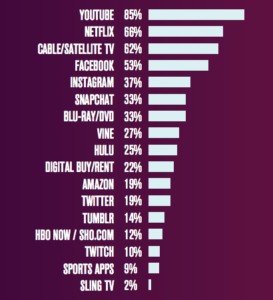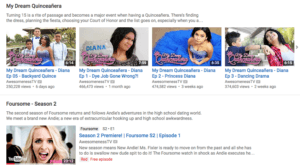How AwesomenessTV Became Awesome

To start off, you may be wondering: what exactly is AwesomenessTV and why haven’t I heard of it?
For starters, AwesomenessTV began in 2012 as a multichannel network on YouTube specifically targeting the teenager and pre-teen demographic (so, not us!). Once YouTube started gaining popularity, companies like AwesomenessTV realized that they could create networks of channels on top of YouTube by partnering with content creators. The results are nothing short of astounding: within one year of launch, AwesomenessTV had over 1 billion views on YouTube. Today, it has over 4.6 million YouTube subscribers across 90,000 channels and has generated over 17 billion lifetime views.
AwesomenessTV’s valuation has grown dramatically as well. The company was originally acquired by DreamWorks in May 2013 for $33 million. More recently, in June 2016, Verizon acquired a 24.5% stake in AwesomenessTV for $159 million, implying a valuation of around $650 million.
AwesomenessTV took advantage of changes in viewing habits among young consumers
All the ruckus around cord-cutting has made it very clear that there has been a steep drop off in traditional TV viewing among millennials and Generation Z-ers.
So if the under-25 set is not watching traditional TV, what exactly are they consuming? DEFY Media’s annual research report in 2016 asked 13-24 year olds this exact question with the following results:
It turns out that 85% of the 1,300 youth sampled in the survey watch YouTube consistently. In fact, 67% even claimed that they “couldn’t live without” YouTube.
AwesomenessTV was able to leverage this growth in the popularity of short-form content on YouTube by creating and aggregating content that would appeal to a target audience of teens and pre-teens, who advertisers are also keen to engage with.
How does the business model work?
The business model is rather simple: multichannel networks like AwesomenessTV build large networks of channels on YouTube with related content (in this case, youth-focused content), driving increased traffic to its centralized hub and providing more opportunities for content creators to advertise and promote themselves.
AwesomenessTV aggregates high-quality content that is relevant for viewers, notifying them of new videos that have been added and recommending other content that they may be interested in based on their viewing history and preferences. Multichannel networks work similarly to Netflix’s recommendation engine, becoming an easy-to-use portal that is updated regularly with “awesome”, personalized content.
How does AwesomenessTV work with channel partners?
AwesomenessTV identifies high potential channel partners and signs revenue-sharing agreements with them. In return, AwesomenessTV helps them in a number of compelling ways:
- Content creation & editing – AwesomenessTV has invested in physical sound stages and video editing facilities that channel partners can utilize to produce content. They also directly partner with their best talent to co-produce series that are exclusive to their network
- Monetization – AwesomenessTV drives a ton of traffic to its network, raising CPMs and ad revenues for channel partners. In addition, the most popular channel partners receive access to lucrative sponsorship opportunities. For example, the AwesomenessTV show “Royal Crush” was produced in partnership with Royal Caribbean and has been quite the hit
- Powerful relationships – AwesomenessTV’s founders and investors are well-connected in Hollywood and can generate distribution opportunities for content creators that go beyond YouTube. For example, Nickelodeon purchased two series of AwesomenessTV’s comedy sketch series for television
How will the business model evolve?
IMO, the value of the AwesomenessTV model is not only in scaling ad revenues within the YouTube ecosystem, as multichannel networks must share revenues with both content creators and YouTube, making monetization potentially challenging.
AwesomenessTV was able to best traditional studios at two things: first, at being where Generation Z eyeballs were, and second, at finding ways to produce low-cost yet high-quality digital content. The real value of AwesomenessTV, and multichannel networks more broadly, is in their ability to leverage an enormous network of young viewers to amplify branded content, allowing consumers to engage with those brands more frequently and on their preferred mediums. Now that is something that I believe advertisers are willing to pay dearly for.








Can’t believe they were acquired after just one year! In terms of their relationship with channel partners, I’d imagine that their content creators are spread throughout the country (and even the globe). On top of the physical sound stages and video editing facilities that AwesomenessTV gives partners access to, have they shipped software/hardware packages (premium audio software, higher-quality cameras) to their content creators as well? Or does ATV just happen to have multiple site facilities across the country?
What do you think prevents like-minded content creators from grouping up by themselves and agreeing on similar revenue-sharing terms?
Felix – Thanks for the comment! From what I understand, most of their physical production facilities are based in LA, so rather than shipping equipment they fly content creators to LA when they work with them. You make a really great point about software/hardware capabilities, though. They should definitely explore lower-cost packages that can be directly mailed to channel partners.
I think that most of the contracts that are signed guarantee content creators exclusivity with a particular multichannel network. However, you’re right that new content creators could certainly form a group together and agree on terms. I think it’s tougher given dispersion of talent, making it difficult for content creators to discover one another. I also imagine that it would be harder to coordinate / negotiate revenue-sharing terms.
I guess another related question is: are there enough barriers to entry in this space? I think that there are now several multichannel networks that have gained strong brand recognition and are well-known for focusing on specific interests (i.e. youth, video games, food, etc.). They are probably the easiest networks to turn to when content creators are starting out. That being said, I think there are opportunities for content creators to successfully form their own networks in other interest areas where there isn’t a dominant player yet.
Awesome post – thank you! AwesomenessTV is a really interesting venture, so I am glad you wrote about it. Interestingly, they are even getting into film production, releasing their first full feature, Before I Fall, this spring! Their background in YouTube helped them to cast the film, using talent from their YouTube network in leading roles. Another interesting aspect of YouTube stars is that they are starting to wise up a bit as the industry becomes more mature. Whereas a few years ago they might have been thrilled to partner with a large brand for a “stunt,” they now are commanding large up-front fees as they have realized their true value to advertisers in reaching the highly sought after, yet elusive, pre-teen/teen market.
Thanks for your post Sijia! The relationships between YouTube and the most dominant and successful MCNs like AwesomenessTV are extremely interesting to me given that the two are at once complementary and competitive within the online video ecosystem.
Like you mentioned, companies like AwesomenessTV are building their own brand and growing their capabilities to become talent agencies and small studios. YouTube also has YouTube Spaces for creators to film and produce their own content and is starting to offer branded sponsorship opportunities to creators through their acquisition of FameBit so that creators can stay on YouTube and still make money outside of traditional ad revenue. It seems like there’s going to be a convergence in what all these companies are trying to do and that bumping into one another in the future will be inevitable. How do you see this tension playing out in the next few years as well as on down the line?